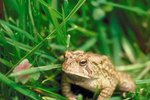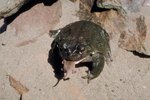
Spadefoot toads are a type of burrowing amphibian with short legs and large eyes. They get their name from the hardened, spade-like projections on their back feet, which are used for digging into soil. The various species of spadefoot toads have unique habitats, defenses, diets and appearances.
Looking in the Mirror
Unlike the skin of true toads, the spadefoot toad's skin is rather smooth, with small, scattered bumps. The colors and patterns of this amphibian depend on the species. For example, eastern spadefoots are tan, olive, black or brown with yellow stripes. In contrast, the Great Basin spadefoot is gray, brown or olive and has dark spots and gray streaks. Couch's spadefoots are green or yellow-green and have varied markings. Spadefoot toads range from 1.3 to 3.5 inches long, depending on the species.
Underground Housing
Spadefoot toads have adapted to live in numerous types of environments. For example, the eastern spadefoot toad favors dry habitats, although it can survive in almost any environment. Species like the Great Basin spadefoot also prefer dry habitats like semidesert shrublands, although they are found in wetlands, forests and woodlands. These amphibians require access to slow-moving water sources like springs, pools or ponds for breeding. When conditions are too dry, the spadefoot is able to bury itself underground in loose, moist soil for up to ten months.
On the Menu
Adult spadefoot toads are not picky eaters. Winged termites, which provide ample fat content, are a large part of the diet of Couch's spadefoot toads. Couch's, Great Basin and eastern spadefoot toads also enjoy invertebrates such as moths, spiders, beetles, snails, caterpillars, millipedes, crickets, beetles and worms. Spadefoot tadpoles begin their life cycle by eating vegetative film and organic matter found floating in water. Growing tadpoles eat anything they can get, including insects, other amphibian larvae and plant matter. As they mature they become carnivores.
Defense Mechanisms
Spadefoot toads have numerous defenses to deter predators like snakes, birds and other frogs. According to the Virginia Herpetological Society, these amphibians expel musky secretions that are irritating to predators' mucous glands if consumed. Spadefoot toads also have pectoral glands above their bellies that contain poison. Additionally, spadefoots have hardened spades on their hind feet that enable them to quickly dig backward into soil to avoid predators.
References
- Virginia Herpetological Society: The Natural History of the Eastern Spadefoot
- State of Connecticut: Eastern Spadefoot Toad
- University of Michigan: Great Basin Spadefoot
- Savannah River Ecology Laboratory: Eastern Spadefoot Toad
- University of Florida: Spadefoot Toad
- The Reptiles and Amphibians of Arizona: Couch's Spadefoot
Resources
Photo Credits
-
Photos.com/Photos.com/Getty Images
Writer Bio
Amanda Williams has been writing since 2009 on various writing websites and blogging since 2003. She enjoys writing about health, medicine, education and home and garden topics. Williams earned a Bachelor of Science in biology at East Stroudsburg University in May 2013. Williams is also a certified emergency medical technician.



